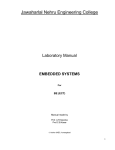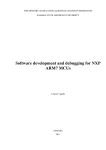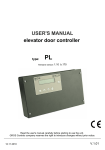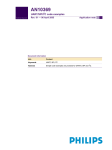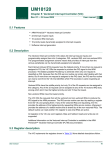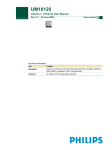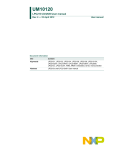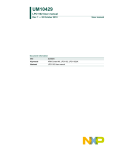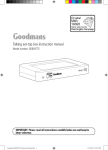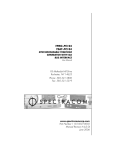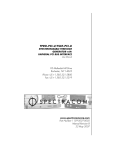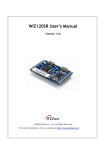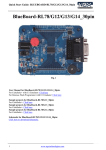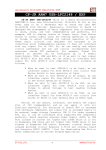Download UM10120 Volume 1: LPC213x User Manual
Transcript
UM10120 Chapter 9: Universal Asynchronous Receiver/Transmitter 0 (UART0) Rev. 01 — 24 June 2005 User manual 9.1 Features • • • • • 16 byte Receive and Transmit FIFOs Register locations conform to ‘550 industry standard. Receiver FIFO trigger points at 1, 4, 8, and 14 bytes. Built-in baud rate generator. LPC2131/2/4/6/8 UART0 contains mechanism that enables software flow control implementation. 9.2 Pin description Table 72: UART0 pin description Pin Type Description RXD0 Input Serial Input. Serial receive data. TXD0 Output Serial Output. Serial transmit data. 9.3 Register description UART0 contains registers organized as shown in Table 73. The Divisor Latch Access Bit (DLAB) is contained in U0LCR[7] and enables access to the Divisor Latches. © Koninklijke Philips Electronics N.V. 2005. All rights reserved. User manual Rev. 01 — 24 June 2005 84 xxxxxxxxxxxxxxxxxxxxx xxxxxxxxxxxxxxxxxxxxxxxxxx xxxxxxx x x x xxxxxxxxxxxxxxxxxxxxxxxxxxxxxx xxxxxxxxxxxxxxxxxxx xx xx xxxxx xxxxxxxxxxxxxxxxxxxxxxxxxxx xxxxxxxxxxxxxxxxxxx xxxxxx xxxxxxxxxxxxxxxxxxxxxxxxxxxxxxxxxxx xxxxxxxxxxxx x x xxxxxxxxxxxxxxxxxxxxx xxxxxxxxxxxxxxxxxxxxxxxxxxxxxx xxxxx xxxxxxxxxxxxxxxxxxxxxxxxxxxxxxxxxxxxxxxxxxxxxxxxxx xxxxxxxx xxxxxxxxxxxxxxxxxxxxxxxxx xxxxxxxxxxxxxxxxxxxx xxx Description Bit functions and addresses MSB BIT7 LSB BIT6 BIT5 BIT4 BIT3 BIT2 BIT1 Access Reset Address value[1] BIT0 Rev. 01 — 24 June 2005 Receiver Buffer Register 8-bit Read Data RO NA 0xE000 C000 (DLAB=0) U0THR Transmit Holding Register 8-bit Write Data WO NA 0xE000 C000 (DLAB=0) U0DLL Divisor Latch LSB 8-bit Data R/W 0x01 0xE000 C000 (DLAB=1) U0DLM Divisor Latch MSB 8-bit Data R/W 0x00 0xE000 C004 (DLAB=1) U0IER Interrupt Enable Register Enable R/W RX Data Available Interrupt 0x00 0xE000 C004 (DLAB=0) U0IIR Interrupt ID Register U0FCR FIFO Control Register U0LCR Line Control Register DLAB Set Break Stick Parity Even Parity Select Parity Enable Number of Stop Bits U0LSR Line Status Register RX FIFO Error TEMT THRE BI FE PE U0SCR Scratch Pad Register U0TER Transmit Enable Register Reserved Reserved Reserved Reserved Reserved Enable RX Line Status Interrupt Enable THRE Interrupt IIR2 IIR1 IIR0 RO 0x01 0xE000 C008 RX FIFO Reset FIFO Enable WO 0x00 0xE000 C008 Word Length Select R/W 0x00 0xE000 C00C RO 0x60 0xE000 C014 R/W 0x00 0xE000 C01C Reserved Reserved Reserved Reserved Reserved Reserved Reserved R/W 0x80 0xE000 C030 FIFOs Enabled [1] RX Trigger Reserved Reserved IIR3 Reserved Reserved Reserved TX FIFO Reset OE 8-bit Data TXEN DR Reset value relects the data stored in used bits only. It does not include reserved bits content. UM10120 Chapter 9: UART0 85 © Koninklijke Philips Electronics N.V. 2005. All rights reserved. U0RBR Philips Semiconductors Name UART0 register map Volume 1 User manual Table 73: UM10120 Philips Semiconductors Volume 1 Chapter 9: UART0 9.3.1 UART0 Receiver Buffer Register (U0RBR - 0xE000 C000, when DLAB = 0, Read Only) The U0RBR is the top byte of the UART0 Rx FIFO. The top byte of the Rx FIFO contains the oldest character received and can be read via the bus interface. The LSB (bit 0) represents the “oldest” received data bit. If the character received is less than 8 bits, the unused MSBs are padded with zeroes. The Divisor Latch Access Bit (DLAB) in U0LCR must be zero in order to access the U0RBR. The U0RBR is always Read Only. Since PE, FE and BI bits correspond to the byte sitting on the top of the RBR FIFO (i.e. the one that will be read in the next read from the RBR), the right approach for fetching the valid pair of received byte and its status bits is first to read the content of the U0LSR register, and then to read a byte from the U0RBR. Table 74: UART0 Receiver Buffer Register (U0RBR - address 0xE000 C000, when DLAB = 0, Read Only) bit description Bit Symbol Description Reset value 7:0 RBR The UART0 Receiver Buffer Register contains the oldest received byte in the UART0 Rx FIFO. undefined 9.3.2 UART0 Transmit Holding Register (U0THR - 0xE000 C000, when DLAB = 0, Write Only) The U0THR is the top byte of the UART0 TX FIFO. The top byte is the newest character in the TX FIFO and can be written via the bus interface. The LSB represents the first bit to transmit. The Divisor Latch Access Bit (DLAB) in U0LCR must be zero in order to access the U0THR. The U0THR is always Write Only. Table 75: UART0 Transmit Holding Register (U0THR - address 0xE000 C000, when DLAB = 0, Write Only) bit description Bit Symbol Description Reset value 7:0 THR Writing to the UART0 Transmit Holding Register causes the data NA to be stored in the UART0 transmit FIFO. The byte will be sent when it reaches the bottom of the FIFO and the transmitter is available. 9.3.3 UART0 Divisor Latch Registers 0 and 1 (U0DLL - 0xE000 C000 and U0DLM - 0xE000 C004, when DLAB = 1) The UART0 Divisor Latch is part of the UART0 Baud Rate Generator and holds the value used to divide the VPB clock (PCLK) in order to produce the baud rate clock, which must be 16x the desired baud rate (Equation 1). The U0DLL and U0DLM registers together form a 16 bit divisor where U0DLL contains the lower 8 bits of the divisor and U0DLM contains the higher 8 bits of the divisor. A 0x0000 value is treated like a 0x0001 value as division by zero is not allowed.The Divisor Latch Access Bit (DLAB) in U0LCR must be one in order to access the UART0 Divisor Latches. Details on how to select the right value for U0DLL and U0DLM can be found later on in this chapter. © Koninklijke Philips Electronics N.V. 2005. All rights reserved. User manual Rev. 01 — 24 June 2005 86 UM10120 Philips Semiconductors Volume 1 Chapter 9: UART0 (1) pclk UART0 baudrate = ----------------------------------------------------------------------------16 × ( 16 × U0DLM + U0DLL ) Table 76: UART0 Divisor Latch LSB register (U0DLL - address 0xE000 C000, when DLAB = 1) bit description Bit Symbol Description Reset value 7:0 DLLSB The UART0 Divisor Latch LSB Register, along with the U0DLM register, determines the baud rate of the UART0. 0x01 Table 77: UART0 Divisor Latch MSB register (U0DLM - address 0xE000 C004, when DLAB = 1) bit description Bit Symbol Description Reset value 7:0 DLMSB The UART0 Divisor Latch MSB Register, along with the U0DLL register, determines the baud rate of the UART0. 0x00 9.3.4 UART0 Baud-rate calculation Example: Using UART0baudrate Equation 1 from above, it can be determined that system with PCLK = 20 MHz, U0DL = 130 (U0DLM = 0x00 and U0DLL = 0x82) will enable UART0 with UART0baudrate=9615 baud. Table 78: Some baud-rates available when using 20 MHz peripheral clock (PCLK=20 MHz) Desired U0DLM:U0DLL baud-rate hex dec % error[1] Desired U0DLM:U0DLL baud-rate hex dec % error[1] 50 0x61A8 25000 0 4800 0x0104 260 0.1603 75 0x411B 16667 0.0020 7200 0x00AE 174 0.2235 110 0x2C64 11364 0.0032 9600 0x0082 130 0.1603 134.5 0x244E 9294 0.0034 19200 0x0041 65 0.1603 150 0x208D 8333 0.0040 38400 0x0021 33 1.3573 300 0x1047 4167 0.0080 56000 0x0021 22 1.4610 600 0x0823 2083 0.0160 57600 0x0016 22 1.3573 1200 0x0412 1042 0.0320 112000 0x000B 11 1.4610 1800 0x02B6 694 0.0640 115200 0x000B 11 1.3573 2000 0x0271 625 0 224000 0x0006 6 6.9940 2400 0x0209 521 0.0320 448000 0x0003 3 6.9940 3600 0x015B 347 0.0640 [1] Relative error calculated as: actual_baudrate/desired_baudrate-1. Actual baudrate based on Equation 1. 9.3.5 UART0 Interrupt Enable Register (U0IER - 0xE000 C004, when DLAB = 0) The U0IER is used to enable the three UART0 interrupt sources. © Koninklijke Philips Electronics N.V. 2005. All rights reserved. User manual Rev. 01 — 24 June 2005 87 UM10120 Philips Semiconductors Volume 1 Chapter 9: UART0 Table 79: UART0 Interrupt Enable Register (U0IER - address 0xE000 C004, when DLAB = 0) bit description Bit Symbol 0 RBR Interrupt Enable 1 2 7:3 THRE Interrupt Enable Value Description Reset value U0IER[0] enables the Receive Data Available interrupt for UART0. It also controls the Character Receive Time-out interrupt. 0 0 Disable the RDA interrupts. 1 Enable the RDA interrupts. U0IER[1] enables the THRE interrupt for UART0. The status of this can be read from U0LSR[5]. 0 Disable the THRE interrupts. 1 Enable the THRE interrupts. RX Line Status Interrupt Enable 0 U0IER[2] enables the UART0 RX line status interrupts. 0 The status of this interrupt can be read from U0LSR[4:1]. 0 Disable the RX line status interrupts. 1 Enable the RX line status interrupts. - Reserved, user software should not write ones to reserved bits. The value read from a reserved bit is not defined. NA 9.3.6 UART0 Interrupt Identification Register (U0IIR - 0xE000 C008, Read Only) The U0IIR provides a status code that denotes the priority and source of a pending interrupt. The interrupts are frozen during an U0IIR access. If an interrupt occurs during an U0IIR access, the interrupt is recorded for the next U0IIR access. Table 80: UART0 Interrupt Identification Register (UOIIR - address 0xE000 C008, read only) bit description Bit Symbol 0 Interrupt Pending 3:1 Value Description Reset value Note that U0IIR[0] is active low. The pending interrupt can be determined by evaluating U0IIR[3:1]. 1 0 At least one interrupt is pending. 1 No pending interrupts. Interrupt Identification U0IER[3:1] identifies an interrupt corresponding to the UART0 Rx FIFO. All other combinations of U0IER[3:1] not listed above are reserved (000,100,101,111). 011 1 - Receive Line Status (RLS). 010 2a - Receive Data Available (RDA). 110 2b - Character Time-out Indicator (CTI). 001 3 - THRE Interrupt 0 5:4 - Reserved, user software should not write ones to reserved bits. The value read from a reserved bit is not defined. NA 7:6 FIFO Enable These bits are equivalent to U0FCR[0]. 0 © Koninklijke Philips Electronics N.V. 2005. All rights reserved. User manual Rev. 01 — 24 June 2005 88 UM10120 Philips Semiconductors Volume 1 Chapter 9: UART0 Interrupts are handled as described in Table 81. Given the status of U0IIR[3:0], an interrupt handler routine can determine the cause of the interrupt and how to clear the active interrupt. The U0IIR must be read in order to clear the interrupt prior to exiting the Interrupt Service Routine. The UART0 RLS interrupt (U0IIR[3:1] = 011) is the highest priority interrupt and is set whenever any one of four error conditions occur on the UART0 Rx input: overrun error (OE), parity error (PE), framing error (FE) and break interrupt (BI). The UART0 Rx error condition that set the interrupt can be observed via U0LSR[4:1]. The interrupt is cleared upon an U0LSR read. The UART0 RDA interrupt (U0IIR[3:1] = 010) shares the second level priority with the CTI interrupt (U0IIR[3:1] = 110). The RDA is activated when the UART0 Rx FIFO reaches the trigger level defined in U0FCR[7:6] and is reset when the UART0 Rx FIFO depth falls below the trigger level. When the RDA interrupt goes active, the CPU can read a block of data defined by the trigger level. The CTI interrupt (U0IIR[3:1] = 110) is a second level interrupt and is set when the UART0 Rx FIFO contains at least one character and no UART0 Rx FIFO activity has occurred in 3.5 to 4.5 character times. Any UART0 Rx FIFO activity (read or write of UART0 RSR) will clear the interrupt. This interrupt is intended to flush the UART0 RBR after a message has been received that is not a multiple of the trigger level size. For example, if a peripheral wished to send a 105 character message and the trigger level was 10 characters, the CPU would receive 10 RDA interrupts resulting in the transfer of 100 characters and 1 to 5 CTI interrupts (depending on the service routine) resulting in the transfer of the remaining 5 characters. Table 81: UART0 interrupt handling U0IIR[3:0] Priority Interrupt Type value[1] Interrupt Source 0001 None None - Interrupt Reset - 0110 Highest RX Line Status / Error OE[2] 0100 Second RX Data Available Rx data available or trigger level reached in FIFO (U0FCR0=1) U0RBR Read[3] or UART0 FIFO drops below trigger level 1100 Second Character Time-out indication Minimum of one character in the Rx FIFO and no character input or removed during a time period depending on how many characters are in FIFO and what the trigger level is set at (3.5 to 4.5 character times). U0RBR Read[3] or PE[2] or FE[2] or BI[2] U0LSR Read[2] The exact time will be: [(word length) × 7 − 2] × 8 + [(trigger level − number of characters) × 8 + 1] RCLKs 0010 Third THRE THRE[2] U0IIR Read (if source of interrupt) or THR write[4] [1] Values "0000", “0011”, “0101”, “0111”, “1000”, “1001”, “1010”, “1011”,”1101”,”1110”,”1111” are reserved. [2] For details see Section 9.3.9 “UART0 Line Status Register (U0LSR - 0xE000 C014, Read Only)” [3] For details see Section 9.3.1 “UART0 Receiver Buffer Register (U0RBR - 0xE000 C000, when DLAB = 0, Read Only)” [4] For details see Section 9.3.6 “UART0 Interrupt Identification Register (U0IIR - 0xE000 C008, Read Only)” and Section 9.3.2 “UART0 Transmit Holding Register (U0THR - 0xE000 C000, when DLAB = 0, Write Only)” © Koninklijke Philips Electronics N.V. 2005. All rights reserved. User manual Rev. 01 — 24 June 2005 89 UM10120 Philips Semiconductors Volume 1 Chapter 9: UART0 The UART0 THRE interrupt (U0IIR[3:1] = 001) is a third level interrupt and is activated when the UART0 THR FIFO is empty provided certain initialization conditions have been met. These initialization conditions are intended to give the UART0 THR FIFO a chance to fill up with data to eliminate many THRE interrupts from occurring at system start-up. The initialization conditions implement a one character delay minus the stop bit whenever THRE=1 and there have not been at least two characters in the U0THR at one time since the last THRE = 1 event. This delay is provided to give the CPU time to write data to U0THR without a THRE interrupt to decode and service. A THRE interrupt is set immediately if the UART0 THR FIFO has held two or more characters at one time and currently, the U0THR is empty. The THRE interrupt is reset when a U0THR write occurs or a read of the U0IIR occurs and the THRE is the highest interrupt (U0IIR[3:1] = 001). 9.3.7 UART0 FIFO Control Register (U0FCR - 0xE000 C008) The U0FCR controls the operation of the UART0 Rx and TX FIFOs. Table 82: UART0 FIFO Control Register (U0FCR - address 0xE000 C008) bit description Bit Symbol 0 FIFO Enable 0 Value Description Reset value UART0 FIFOs are disabled. Must not be used in the 0 application. 1 Active high enable for both UART0 Rx and TX FIFOs and U0FCR[7:1] access. This bit must be set for proper UART0 operation. Any transition on this bit will automatically clear the UART0 FIFOs. RX FIFO Reset 0 No impact on either of UART0 FIFOs. 1 Writing a logic 1 to U0FCR[1] will clear all bytes in UART0 Rx FIFO and reset the pointer logic. This bit is self-clearing. TX FIFO Reset 0 No impact on either of UART0 FIFOs. 1 Writing a logic 1 to U0FCR[2] will clear all bytes in UART0 TX FIFO and reset the pointer logic. This bit is self-clearing. 5:3 - 0 Reserved, user software should not write ones to reserved bits. The value read from a reserved bit is not defined. NA 7:6 RX Trigger Level These two bits determine how many receiver UART0 FIFO characters must be written before an interrupt is activated. 0 1 2 00 0 0 Trigger level 0 (1 character or 0x01) 01 Trigger level 1 (4 characters or 0x04) 10 Trigger level 2 (8 characters or 0x08) 11 Trigger level 3 (14 characters or 0x0E) 9.3.8 UART0 Line Control Register (U0LCR - 0xE000 C00C) The U0LCR determines the format of the data character that is to be transmitted or received. © Koninklijke Philips Electronics N.V. 2005. All rights reserved. User manual Rev. 01 — 24 June 2005 90 UM10120 Philips Semiconductors Volume 1 Table 83: Chapter 9: UART0 UART0 Line Control Register (U0LCR - address 0xE000 C00C) bit description Bit Symbol Value Description Reset value 1:0 Word Length Select 00 5 bit character length 0 01 6 bit character length 10 7 bit character length 11 8 bit character length 0 1 stop bit. 1 2 stop bits (1.5 if U0LCR[1:0]=00). 0 Disable parity generation and checking. 1 Enable parity generation and checking. 00 Odd parity. Number of 1s in the transmitted character and the attached parity bit will be odd. 01 Even Parity. Number of 1s in the transmitted character and the attached parity bit will be even. 10 Forced "1" stick parity. 11 Forced "0" stick parity. 0 Disable break transmission. 1 Enable break transmission. Output pin UART0 TXD is forced to logic 0 when U0LCR[6] is active high. 2 3 5:4 6 7 Stop Bit Select Parity Enable Parity Select Break Control Divisor Latch 0 Access Bit (DLAB) 1 0 0 0 0 Disable access to Divisor Latches. 0 Enable access to Divisor Latches. 9.3.9 UART0 Line Status Register (U0LSR - 0xE000 C014, Read Only) The U0LSR is a read-only register that provides status information on the UART0 TX and RX blocks. Table 84: UART0 Line Status Register (U0LSR - address 0xE000 C014, read only) bit description Bit Symbol 0 1 2 Receiver Data Ready (RDR) Value Description Reset value U0LSR0 is set when the U0RBR holds an unread character and is cleared when the UART0 RBR FIFO is empty. 0 U0RBR is empty. 1 U0RBR contains valid data. Overrun Error (OE) 0 The overrun error condition is set as soon as it occurs. An U0LSR read clears 0 U0LSR1. U0LSR1 is set when UART0 RSR has a new character assembled and the UART0 RBR FIFO is full. In this case, the UART0 RBR FIFO will not be overwritten and the character in the UART0 RSR will be lost. 0 Overrun error status is inactive. 1 Overrun error status is active. Parity Error (PE) When the parity bit of a received character is in the wrong state, a parity error 0 occurs. An U0LSR read clears U0LSR[2]. Time of parity error detection is dependent on U0FCR[0]. Note: A parity error is associated with the character at the top of the UART0 RBR FIFO. 0 Parity error status is inactive. 1 Parity error status is active. © Koninklijke Philips Electronics N.V. 2005. All rights reserved. User manual Rev. 01 — 24 June 2005 91 UM10120 Philips Semiconductors Volume 1 Table 84: UART0 Line Status Register (U0LSR - address 0xE000 C014, read only) bit description Bit Symbol 3 Chapter 9: UART0 Value Description Framing Error (FE) Reset value When the stop bit of a received character is a logic 0, a framing error occurs. 0 An U0LSR read clears U0LSR[3]. The time of the framing error detection is dependent on U0FCR0. Upon detection of a framing error, the Rx will attempt to resynchronize to the data and assume that the bad stop bit is actually an early start bit. However, it cannot be assumed that the next received byte will be correct even if there is no Framing Error. Note: A framing error is associated with the character at the top of the UART0 RBR FIFO. 4 0 Framing error status is inactive. 1 Framing error status is active. Break Interrupt (BI) When RXD0 is held in the spacing state (all 0’s) for one full character 0 transmission (start, data, parity, stop), a break interrupt occurs. Once the break condition has been detected, the receiver goes idle until RXD0 goes to marking state (all 1’s). An U0LSR read clears this status bit. The time of break detection is dependent on U0FCR[0]. Note: The break interrupt is associated with the character at the top of the UART0 RBR FIFO. 5 6 7 Transmitter Holding Register Empty (THRE)) Transmitter Empty (TEMT) 0 Break interrupt status is inactive. 1 Break interrupt status is active. THRE is set immediately upon detection of an empty UART0 THR and is cleared on a U0THR write. 0 U0THR contains valid data. 1 U0THR is empty. 1 TEMT is set when both U0THR and U0TSR are empty; TEMT is cleared when 1 either the U0TSR or the U0THR contain valid data. 0 U0THR and/or the U0TSR contains valid data. 1 U0THR and the U0TSR are empty. Error in RX FIFO (RXFE) U0LSR[7] is set when a character with a Rx error such as framing error, parity 0 error or break interrupt, is loaded into the U0RBR. This bit is cleared when the U0LSR register is read and there are no subsequent errors in the UART0 FIFO. 0 U0RBR contains no UART0 RX errors or U0FCR[0]=0. 1 UART0 RBR contains at least one UART0 RX error. 9.3.10 UART0 Scratch pad register (U0SCR - 0xE000 C01C) The U0SCR has no effect on the UART0 operation. This register can be written and/or read at user’s discretion. There is no provision in the interrupt interface that would indicate to the host that a read or write of the U0SCR has occurred. Table 85: UART0 Scratch pad register (U0SCR - address 0xE000 C01C) bit description Bit Symbol Description Reset value 7:0 Pad A readable, writable byte. 0x00 © Koninklijke Philips Electronics N.V. 2005. All rights reserved. User manual Rev. 01 — 24 June 2005 92 UM10120 Philips Semiconductors Volume 1 Chapter 9: UART0 9.3.11 UART0 Transmit Enable Register (U0TER - 0xE000 C030) LPC2131/2/4/6/8’s U0TER enables implementation of software flow control. When TXEn=1, UART0 transmitter will keep sending data as long as they are available. As soon as TXEn becomes 0, UART0 transmittion will stop. Table 86 describes how to use TXEn bit in order to achieve software flow control. Table 86: UART0 Transmit Enable Register (U0TER - address 0xE000 C030) bit description Bit Symbol Description Reset value 6:0 - Reserved, user software should not write ones to reserved bits. The value read from a reserved bit is not defined. NA 7 TXEN When this bit is 1, as it is after a Reset, data written to the THR is output 1 on the TXD pin as soon as any preceding data has been sent. If this bit is cleared to 0 while a character is being sent, the transmission of that character is completed, but no further characters are sent until this bit is set again. In other words, a 0 in this bit blocks the transfer of characters from the THR or TX FIFO into the transmit shift register. Software implementing software-handshaking can clear this bit when it receives an XOFF character (DC3). Software can set this bit again when it receives an XON (DC1) character. 9.4 Architecture The architecture of the UART0 is shown below in the block diagram. The VPB interface provides a communications link between the CPU or host and the UART0. The UART0 receiver block, U0RX, monitors the serial input line, RXD0, for valid input. The UART0 RX Shift Register (U0RSR) accepts valid characters via RXD0. After a valid character is assembled in the U0RSR, it is passed to the UART0 RX Buffer Register FIFO to await access by the CPU or host via the generic host interface. The UART0 transmitter block, U0TX, accepts data written by the CPU or host and buffers the data in the UART0 TX Holding Register FIFO (U0THR). The UART0 TX Shift Register (U0TSR) reads the data stored in the U0THR and assembles the data to transmit via the serial output pin, TXD0. The UART0 Baud Rate Generator block, U0BRG, generates the timing enables used by the UART0 TX block. The U0BRG clock input source is the VPB clock (PCLK). The main clock is divided down per the divisor specified in the U0DLL and U0DLM registers. This divided down clock is a 16x oversample clock, NBAUDOUT. The interrupt interface contains registers U0IER and U0IIR. The interrupt interface receives several one clock wide enables from the U0TX and U0RX blocks. Status information from the U0TX and U0RX is stored in the U0LSR. Control information for the U0TX and U0RX is stored in the U0LCR. © Koninklijke Philips Electronics N.V. 2005. All rights reserved. User manual Rev. 01 — 24 June 2005 93 UM10120 Philips Semiconductors Volume 1 Chapter 9: UART0 U0TX U0THR NTXRDY U0TSR TXD0 U0BRG U0DLL NBAUDOUT U0DLM RCLK U0RX NRXRDY INTERRUPT U0RBR U0INTR U0RSR RXD0 U0IER U0IIR U0FCR U0LSR U0SCR U0LCR PA[2:0] PSEL PSTB PWRITE PD[7:0] VPB INTERFACE DDIS AR MR PCLK Fig 18. LPC2131/2/4/6/8 UART0 block diagram © Koninklijke Philips Electronics N.V. 2005. All rights reserved. User manual Rev. 01 — 24 June 2005 94











